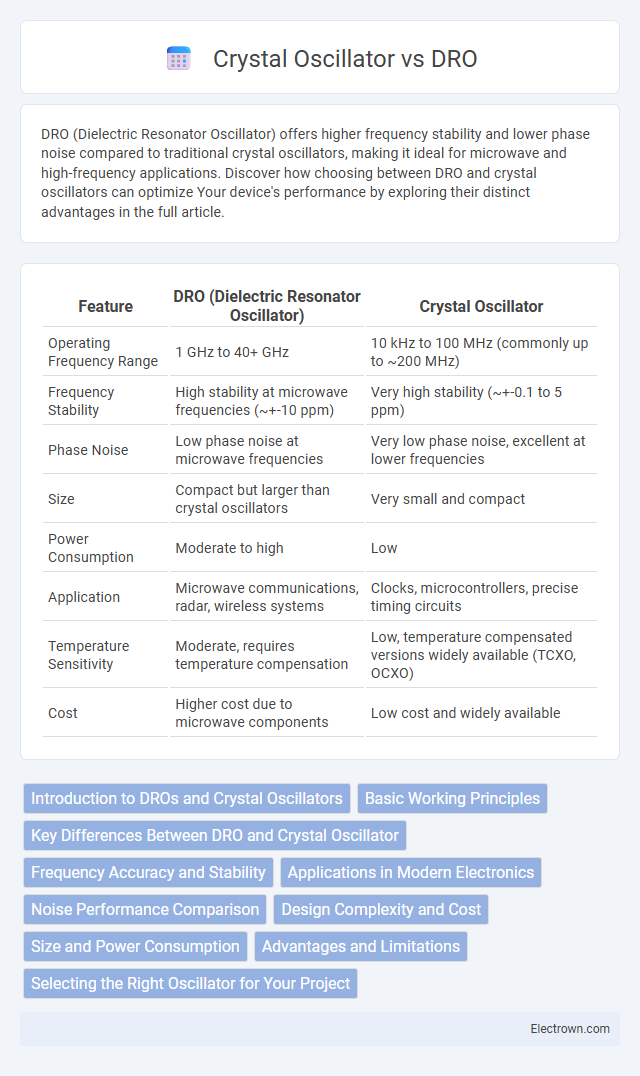DRO (Dielectric Resonator Oscillator) offers higher frequency stability and lower phase noise compared to traditional crystal oscillators, making it ideal for microwave and high-frequency applications. Discover how choosing between DRO and crystal oscillators can optimize Your device's performance by exploring their distinct advantages in the full article.
Table of Comparison
| Feature | DRO (Dielectric Resonator Oscillator) | Crystal Oscillator |
|---|---|---|
| Operating Frequency Range | 1 GHz to 40+ GHz | 10 kHz to 100 MHz (commonly up to ~200 MHz) |
| Frequency Stability | High stability at microwave frequencies (~+-10 ppm) | Very high stability (~+-0.1 to 5 ppm) |
| Phase Noise | Low phase noise at microwave frequencies | Very low phase noise, excellent at lower frequencies |
| Size | Compact but larger than crystal oscillators | Very small and compact |
| Power Consumption | Moderate to high | Low |
| Application | Microwave communications, radar, wireless systems | Clocks, microcontrollers, precise timing circuits |
| Temperature Sensitivity | Moderate, requires temperature compensation | Low, temperature compensated versions widely available (TCXO, OCXO) |
| Cost | Higher cost due to microwave components | Low cost and widely available |
Introduction to DROs and Crystal Oscillators
Dielectric Resonator Oscillators (DROs) utilize high-permittivity ceramic materials to generate stable microwave frequencies, making them ideal for radar and communication systems operating in the GHz range. Crystal oscillators rely on the piezoelectric properties of quartz crystals to produce precise and low-phase-noise signals commonly used in clock generation and frequency reference applications within MHz to low GHz ranges. The choice between DROs and crystal oscillators hinges on frequency range, stability requirements, and phase noise performance specific to the application's needs.
Basic Working Principles
A Dielectric Resonator Oscillator (DRO) generates a stable frequency by utilizing the high-Q dielectric resonator's electromagnetic energy storage properties, which provides low phase noise and high frequency stability. In contrast, a Crystal Oscillator relies on the piezoelectric effect of quartz crystals, where mechanical vibrations induce an electrical signal at a precise resonant frequency. Your choice depends on application requirements for frequency range, stability, and noise performance.
Key Differences Between DRO and Crystal Oscillator
DRO (Dielectric Resonator Oscillator) and crystal oscillators differ primarily in frequency stability and range, with crystal oscillators offering superior long-term stability but limited high-frequency operation typically below 200 MHz. DROs utilize dielectric resonators to achieve high-frequency oscillations in the microwave range (GHz), making them ideal for applications requiring compact size and low phase noise at high frequencies. Your choice depends on the specific frequency requirements, stability needs, and application environment, as crystal oscillators excel in precision timing while DROs provide robust performance at microwave frequencies.
Frequency Accuracy and Stability
DROs (Dielectric Resonator Oscillators) offer superior frequency stability due to their high Q-factor dielectric resonators, maintaining consistent frequency under temperature variations and mechanical vibrations. Crystal oscillators provide excellent frequency accuracy with tight initial tolerance but can be more susceptible to aging and environmental factors. Your choice between DRO and crystal oscillators depends on whether long-term stability or initial frequency precision is the priority.
Applications in Modern Electronics
DROs (Dielectric Resonator Oscillators) are widely used in high-frequency applications such as radar systems, microwave communication, and satellite transponders due to their superior frequency stability and low phase noise at microwave frequencies. Crystal oscillators remain the preferred choice in consumer electronics, microcontrollers, and digital circuits for their high precision and cost-effectiveness at lower frequencies. Your selection between DRO and crystal oscillators depends on the required operating frequency, stability, and the complexity of the electronic system.
Noise Performance Comparison
DRO (Dielectric Resonator Oscillator) typically exhibits lower phase noise compared to a crystal oscillator, especially at microwave frequencies, due to its high Q-factor and stability. Crystal oscillators, while excellent for low-frequency applications, often show higher close-in phase noise because of their mechanical resonance limitations. For your high-precision RF systems, choosing a DRO can significantly improve noise performance and signal quality.
Design Complexity and Cost
DROs (Dielectric Resonator Oscillators) feature higher design complexity due to their reliance on dielectric materials and cavity structures, resulting in more intricate tuning and assembly processes compared to crystal oscillators. Crystal oscillators typically offer lower cost and simpler manufacturing, benefiting from mature quartz crystal technology and mass production. Your choice depends on balancing DRO's precision performance with crystal oscillators' cost-effectiveness and ease of integration.
Size and Power Consumption
DROs (Dielectric Resonator Oscillators) generally offer smaller sizes compared to crystal oscillators, making them ideal for compact electronic devices requiring stable microwave frequencies. Power consumption in DROs tends to be higher due to their microwave operation, whereas crystal oscillators are more energy-efficient, especially at lower frequencies. Your choice depends on whether compact size or lower power usage is the priority in your application.
Advantages and Limitations
DROs (Dielectric Resonator Oscillators) offer superior phase noise performance and frequency stability compared to crystal oscillators, making them ideal for high-frequency microwave applications. Crystal oscillators provide excellent frequency accuracy and low cost, with widespread availability and ease of integration in low-frequency circuits. However, DROs are generally more expensive and bulkier, while crystal oscillators are limited by lower frequency ranges and susceptibility to environmental changes.
Selecting the Right Oscillator for Your Project
Selecting the right oscillator for your project hinges on stability, frequency accuracy, and environmental factors; Dielectric Resonator Oscillators (DROs) offer superior phase noise performance and frequency stability in microwave applications, making them ideal for high-frequency communications and radar systems. Crystal oscillators, with their cost-effectiveness and excellent frequency accuracy at lower frequencies, suit applications like microcontrollers, clocks, and consumer electronics. Evaluating parameters such as frequency range, phase noise, thermal stability, and power consumption ensures optimal oscillator selection tailored to your project's specific requirements.
DRO vs crystal oscillator Infographic

 electrown.com
electrown.com